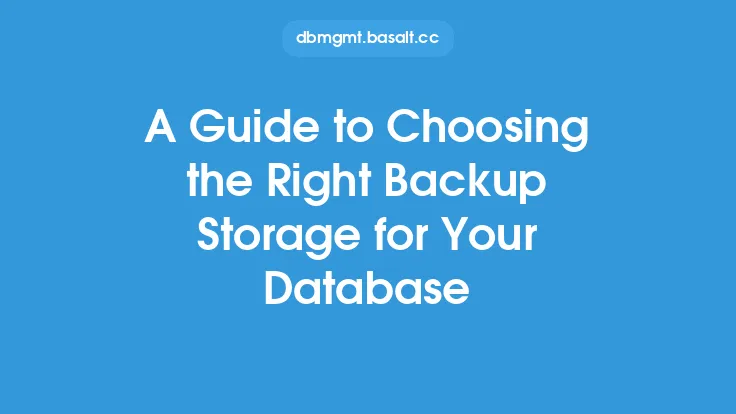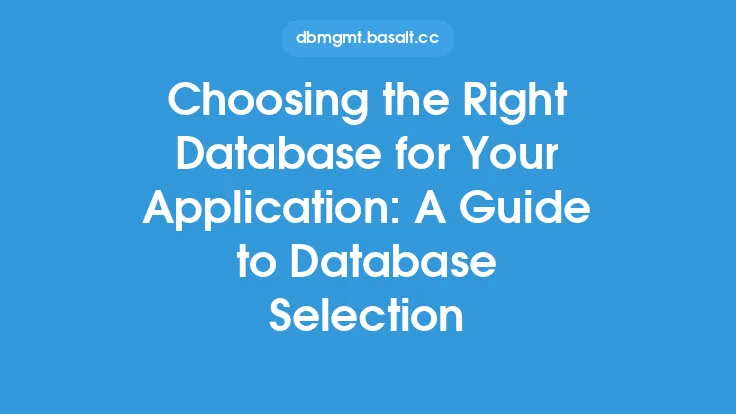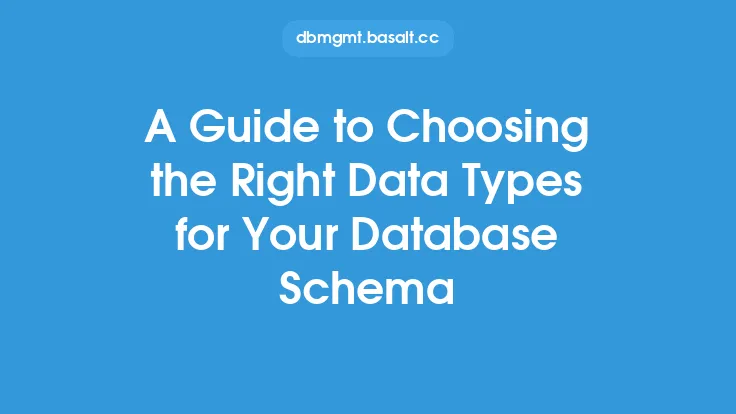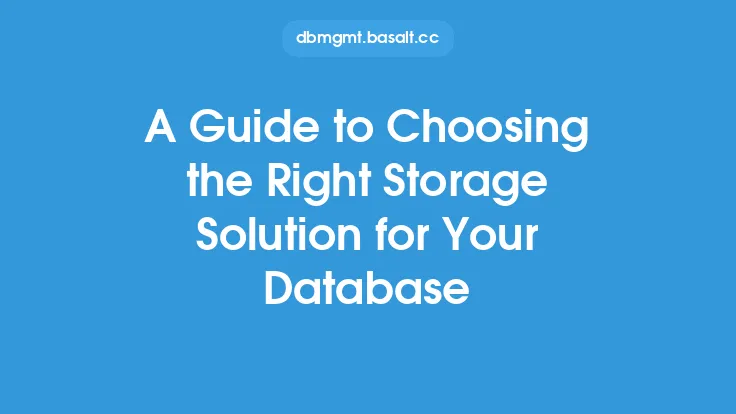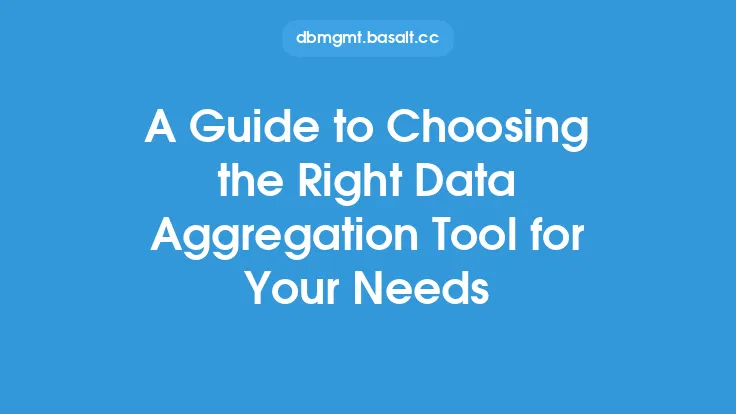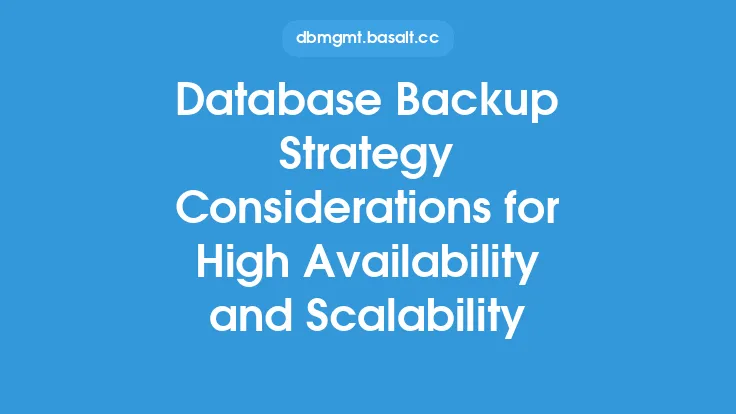When it comes to database backup strategies, there is no one-size-fits-all solution. Every business has unique needs and requirements, and the right backup strategy will depend on a variety of factors, including the type and size of the database, the level of data criticality, and the available resources. In this article, we will explore the key considerations for choosing the right database backup strategy for your business needs.
Understanding Database Backup Requirements
To develop an effective database backup strategy, it's essential to understand the requirements of your business. This includes identifying the types of data that need to be backed up, the frequency of backups, and the retention period for backup data. You should also consider the recovery time objective (RTO) and recovery point objective (RPO) for your database. The RTO refers to the maximum amount of time that your business can afford to be without access to its data, while the RPO refers to the maximum amount of data that can be lost in the event of a disaster. By understanding these requirements, you can develop a backup strategy that meets the needs of your business and ensures the availability and integrity of your data.
Evaluating Database Backup Options
There are several database backup options available, including on-premises backups, cloud-based backups, and hybrid backups. On-premises backups involve storing backup data on local servers or storage devices, while cloud-based backups involve storing backup data in the cloud. Hybrid backups combine on-premises and cloud-based backups, providing a flexible and scalable solution. When evaluating database backup options, you should consider factors such as cost, scalability, security, and ease of management. You should also consider the level of control and flexibility that you need, as well as the level of support and maintenance required.
Database Backup Storage Considerations
The storage of backup data is a critical consideration when developing a database backup strategy. You should consider the type of storage media to use, such as disk, tape, or cloud storage, as well as the capacity and performance requirements of your backup storage. You should also consider the level of redundancy and failover required, as well as the level of data compression and encryption. Additionally, you should consider the cost of storage and the level of scalability required, as well as the level of support and maintenance required.
Database Backup Scheduling and Automation
Database backup scheduling and automation are critical components of a database backup strategy. You should consider the frequency of backups, as well as the timing and duration of backup windows. You should also consider the level of automation required, such as automated backup scheduling, automated backup verification, and automated backup reporting. Additionally, you should consider the level of integration with other systems and tools, such as monitoring and alerting systems, as well as the level of support and maintenance required.
Database Backup Testing and Validation
Database backup testing and validation are critical components of a database backup strategy. You should regularly test and validate your backups to ensure that they are complete, accurate, and recoverable. This includes testing the restore process, as well as validating the integrity and consistency of backup data. You should also consider the level of automation required, such as automated backup testing and validation, as well as the level of integration with other systems and tools, such as monitoring and alerting systems.
Database Backup Security Considerations
Database backup security is a critical consideration when developing a database backup strategy. You should consider the level of encryption required, as well as the level of access control and authentication. You should also consider the level of data masking and anonymization required, as well as the level of compliance with regulatory requirements. Additionally, you should consider the level of support and maintenance required, as well as the level of training and awareness required for backup administrators and other stakeholders.
Database Backup Strategy Implementation
Implementing a database backup strategy requires careful planning and execution. You should start by developing a comprehensive backup plan that outlines the backup strategy, including the types of data to be backed up, the frequency of backups, and the retention period for backup data. You should also consider the level of automation required, as well as the level of integration with other systems and tools. Additionally, you should consider the level of support and maintenance required, as well as the level of training and awareness required for backup administrators and other stakeholders.
Database Backup Strategy Monitoring and Maintenance
Monitoring and maintaining a database backup strategy is critical to ensuring the availability and integrity of your data. You should regularly monitor backup jobs, as well as backup storage and retention. You should also consider the level of automation required, such as automated backup monitoring and reporting, as well as the level of integration with other systems and tools, such as monitoring and alerting systems. Additionally, you should consider the level of support and maintenance required, as well as the level of training and awareness required for backup administrators and other stakeholders.
Conclusion
Choosing the right database backup strategy for your business needs requires careful consideration of a variety of factors, including the type and size of the database, the level of data criticality, and the available resources. By understanding your database backup requirements, evaluating database backup options, and considering database backup storage, scheduling, automation, testing, validation, security, implementation, monitoring, and maintenance, you can develop a comprehensive database backup strategy that meets the needs of your business and ensures the availability and integrity of your data. Remember to regularly review and update your database backup strategy to ensure that it remains effective and aligned with the evolving needs of your business.
